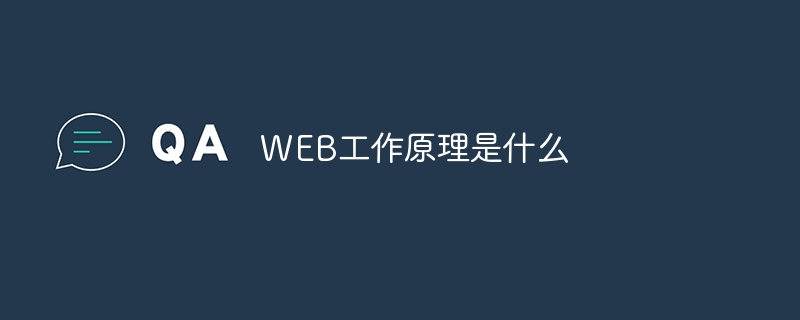
WEB working principle refers to the operation mode and basic principles of various websites and applications on the Internet. Detailed steps: 1. Enter the URL you want to access; 2. The web client sends an HTTP request; 3. During the request process, the client will parse the domain name in the URL into the corresponding IP address; 4. After the parsing is completed, the client will Establish a TCP/IP connection; 5. The server processes the request according to the HTTP request method and request headers; 6. After processing the request, it generates an HTTP response; 7. Processes the response content and displays it to the user.

# Operating system for this tutorial: Windows 10 system, Dell G3 computer.
The working principle of the Web refers to the operation mode and basic principles of various websites and applications on the Internet. With the development and popularization of the Internet, the Web has become an important platform for people to obtain information, communicate and conduct business. Understanding how the web works is important for developers, network administrators, and general users alike.
The basic components of the Web include clients, servers and networks. The client refers to the device used by the user, such as a computer, phone, or tablet. Servers are computers that store and process web pages and applications. A network is a communication medium that connects clients and servers, such as the Internet or a local area network.
The basic principle of Web work is that the client sends a request to the server through the network, and the server receives the request and returns the corresponding content. This process usually uses HTTP (Hypertext Transfer Protocol) for communication. HTTP is a protocol based on the request-response model. The client sends an HTTP request and the server returns an HTTP response.
When the client sends an HTTP request, the request contains the URL (uniform resource locator) of the resource to be accessed, such as a web page, picture or video. After the server receives the request, it will find the corresponding resource according to the URL and send it to the client. This process involves steps such as DNS (Domain Name System) resolution, TCP/IP (Transmission Control Protocol/Internet Protocol) connection and data transmission.
When performing DNS resolution, the client will resolve the domain name in the URL into the corresponding IP address. DNS is a distributed system that maps domain names to IP addresses so that clients can find the correct server. Once parsing is complete, the client can establish a TCP/IP connection.
TCP/IP connection is a reliable, connection-oriented protocol that ensures reliable transmission of data between the client and the server. After a connection is established, a handshake occurs between the client and server to ensure that both parties are ready for data transfer.
During the data transmission process, the HTTP request sent by the client contains the request method (such as GET, POST, etc.) and request headers (such as user agent, cookie, etc.), and the server processes the request based on this information. After the server processes the request, it will generate an HTTP response, which contains the response status code (such as 200 for success, 404 for not found, etc.) and response headers (such as content type, content length, etc.). The content of the response can be an HTML page, CSS style sheet, JavaScript script, image, video or other type of file.
After the client receives the HTTP response, it will process it according to the content of the response. If it is an HTML page, the client will parse the structure and style of the page and display it to the user. If it is a file of other types, the client will process it accordingly based on the file type.
In addition to the basic HTTP protocol, the Web also involves other technologies and protocols, such as HTML (Hypertext Markup Language), CSS (Cascading Style Sheets), JavaScript, AJAX (Asynchronous JavaScript and XML), REST ( Representing state transition), etc. These technologies and protocols provide more possibilities for Web functions and interactions.
In short, the working principle of the Web is a complex and huge system, involving the collaborative work of multiple technologies and protocols. Understanding how the Web works can help us better understand and use the Internet, while also providing developers with guidance and reference so that they can develop better Web applications and websites.
The above is the detailed content of How WEB works. For more information, please follow other related articles on the PHP Chinese website!




